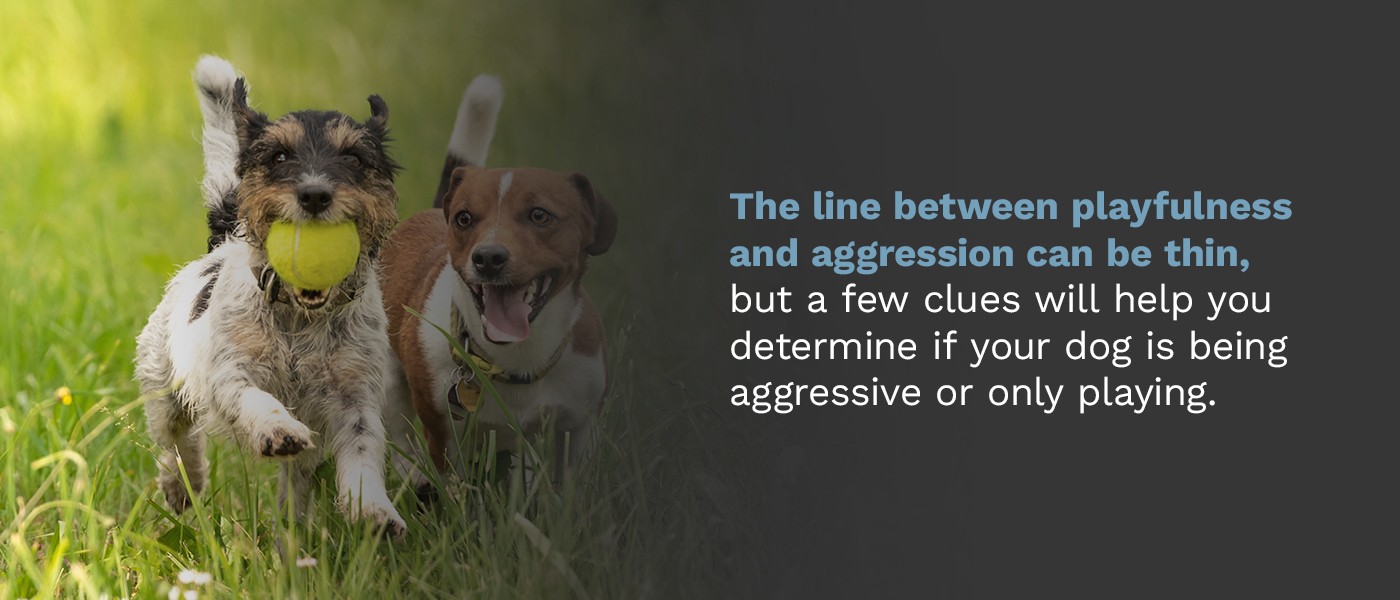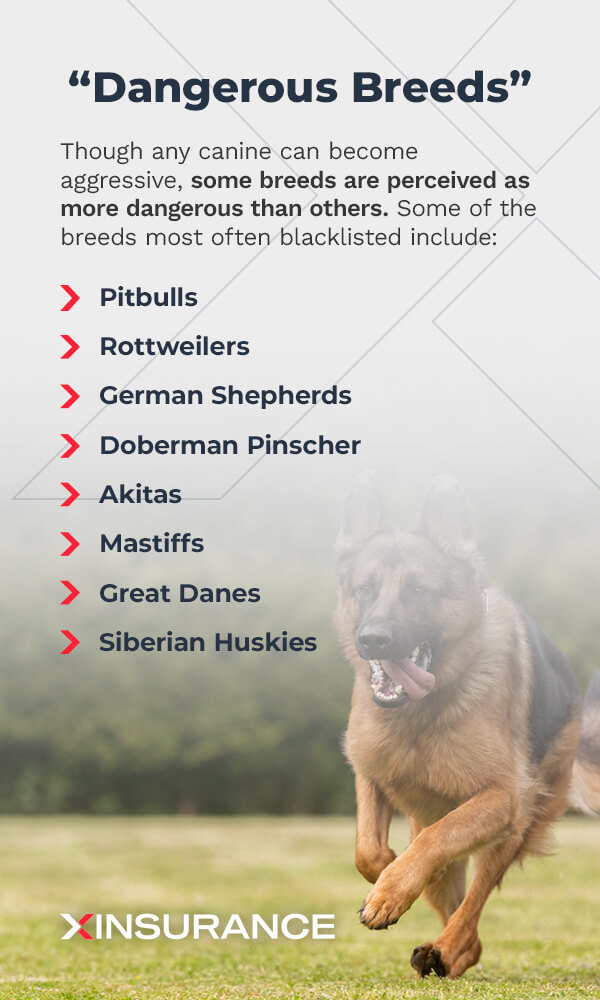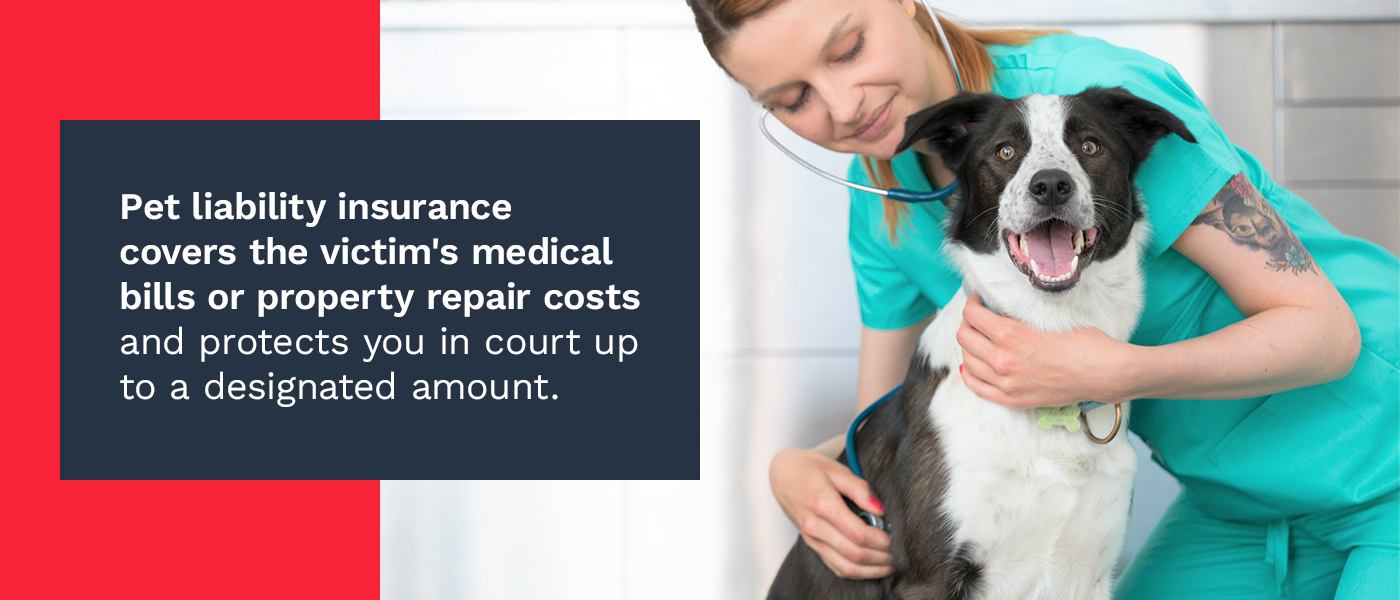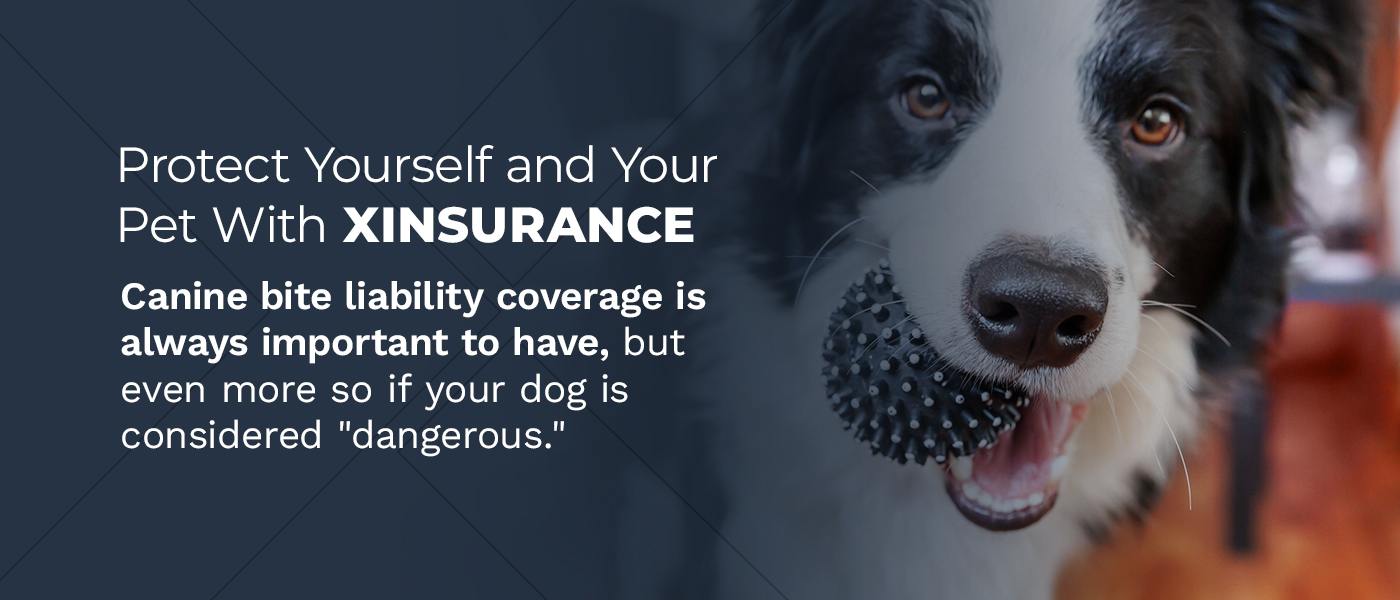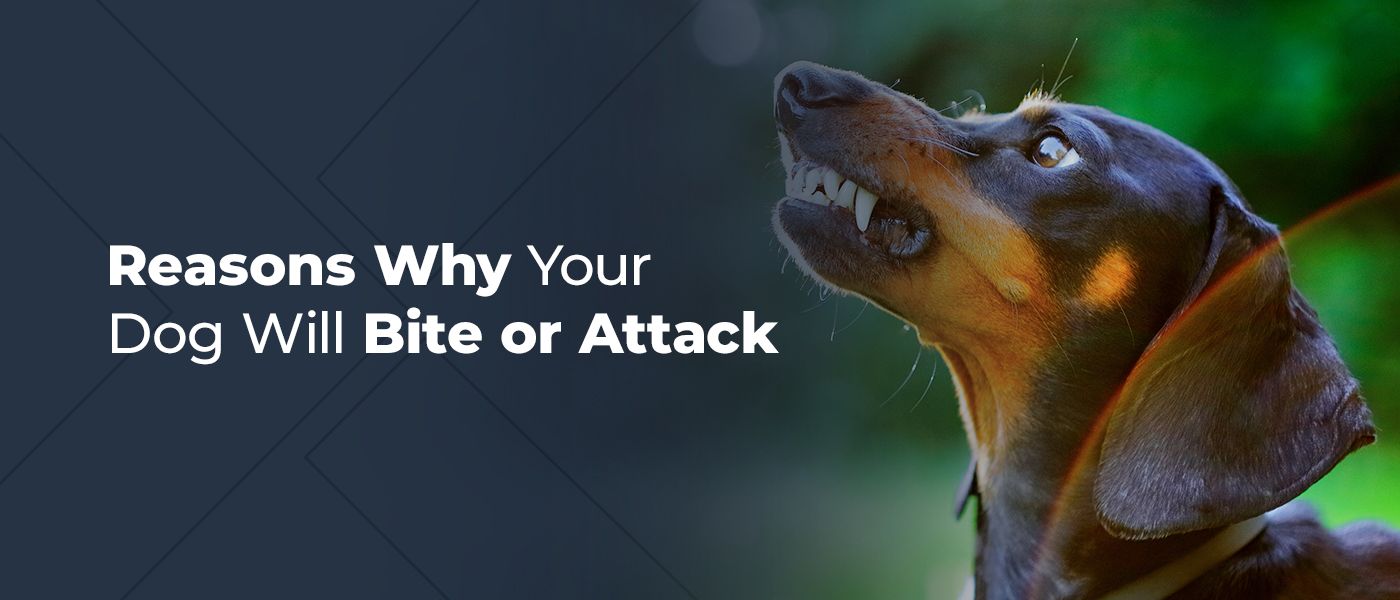
Reasons Why Your Dog Will Bite or Attack
On the other hand, dogs with happy, healthy upbringings might bear their teeth when guarding an object like a bone or toy. It’s a dog’s nature to be possessive of valuable objects. A less common cause of aggression occurs when a dog wants to maintain a position of dominance. If you own a dog, it’s important to recognize the signs of aggression and protect yourself with canine liability insurance. Dog bite liability is important for any dog owner.
How to Identify Signs of Aggressive Dog Behavior
Dogs speak a language that people often misinterpret. Playful behavior can seem aggressive, while aggressive behavior might go unnoticed. All dogs, regardless of breed or size, can become aggressive under the right circumstances. The signs of aggression depend on the situation at hand. Here are some specific behaviors to watch out for.
1. Signs of Dominant Aggression
Keep in mind that a dog is not “dominant” or “submissive” as a character trait. Instead, it can display signs of either depending on the circumstances. Owners tend to assume showing dominance is the cause of an attack when, in reality, other factors are at play. Note that dominant aggression is most common among unfixed male canines. Your dog might be expressing dominant aggression if it:
- Blocks a person or other dog’s pathway.
- Mounts legs or other dogs.
- Barges through doors or lunges toward you.
- Asserts itself between others.
- Continues barking or snarling at a low pitch.
- Growls or snaps.
- Stares at a person or another dog.
- Moves its tail from side to side in stiff motions.
2. Signs of Fear Aggression
A defensive aggressive canine might be less obvious. If you notice signs of fear, approaching or touching the dog might cause it to panic and lash out. Keep a safe distance until the dog relaxes. Watch for signs of submissive body language, including:
- Holding its ears back.
- Avoiding eye contact.
- Lowering its head and body.
- Tucking its tail between its legs.
- Urinating.
3. Signs of Possessive Aggression
Possessive aggression is easier to spot. It only occurs if a dog has something to feel possessive of, like food, treats, toys or a favorite person. If your dog growls or snaps at you when you approach their food bowl or try to take away a toy, this is a sign of possessive aggression. A reaction like this is common if a dog has had to compete for resources in the past, perhaps at an overcrowded shelter. Another cause might be the introduction of a new rival.
Aggressive or Playing?
The line between playfulness and aggression can be thin, but a few clues will help you determine if your dog is being aggressive or only playing. When two dogs are playing, a good sign is constant role reversal. For instance, switching back and forth between chasing one another shows positive role reversal. It’s also a good sign if a larger dog takes on a “handicap” by laying down when playing with a smaller animal.
In most cases, only two dogs should play with each other at a time. When three or more canines play with each other, it’s easy for one to become a target. Watch out for the warning signs of playtime aggression, which include:
- Obsessive behavior, when one dog refuses to leave another alone.
- Attempting to mount each other.
- A lack of role reversal in submission and dominance.
How to Stop Aggressive Behavior
If you want to stop aggressive behavior, pay attention to the type of aggression your dog displays. This can help you determine the appropriate action. For example, if your male dog is showing signs of dominant aggression, and he hasn’t been fixed, getting him neutered might help alleviate the issue.
However, no matter the type of aggressive behavior, understand that trying to punish it with assertive force or violence can make your dog’s underlying attitude much worse. While you may get temporary submission, your dog will likely become more aggressive in the long-term. Instead, use positive reinforcement for good behavior and psychological tricks.
As an owner, you can reduce your dog’s tendency toward aggression. If you rescued your dog from an abusive environment, you’ll have to reassure its feelings of safety and comfort. Respect a canine’s personal space, especially while it’s sleeping or eating. Train and socialize with caution and patience. Limit situations that result in aggressive behavior, and invest in dog liability insurance.
How to Protect Yourself From an Aggressive Dog
If a dog is showing signs of aggression, stay calm. Do not yell, kick, run away or make eye contact with the dog. All of these reactions may escalate aggression. Baring teeth, yelling or making eye contact are signs of challenge, and running away can activate a predator-prey instinct. The best thing to do is turn to the side, cross your arms and stand still. If you can, put an arm out away from your torso or offer something else the dog can bite other than your body.
If a dog does bite you, your instinct will make you want to pull away. This can make the injury more severe, though. Instead, reach for the dog’s legs to knock it off balance. If a dog knocks you over, stay still on the ground, protecting your torso. Squirming or wriggling away will increase the dog’s aggressive instincts. As a general rule, try to be as inanimate as possible, which will make the dog lose interest.
“Dangerous Breeds”
Though any canine can become aggressive, some breeds are perceived as more dangerous than others. Because of these stereotypes, dog bite liability insurance companies blacklist certain breeds. These companies cite reports and statistics, but more prevalent dog breeds are bound to pop up in the news more often than others. In addition, the media is more likely to identify a dog breed if it’s already thought to be aggressive. Many organizations denounce breed-specific legislation, including the American Bar Association and the Center for Disease Control. Regardless, some of the breeds most often blacklisted include:
- Pitbulls: This should come as no surprise. Pitbulls have a bad reputation because they’re often used in dogfighting. They tend to have a hold and shake” way of biting, which causes more severe injuries. Studies show pitbull breeds are probably no more dangerous than other dogs, but public opinion persists. If you research Pitbulls, you’re bound to find a lot of contradictory information.
- Rottweilers: The rottweiler is large and muscular, bred for driving cattle or pulling carts. Because of their appearance and sensational stories of attacks, rottweilers have found themselves on the blacklist. Like any other dog, they can be territorial and aggressive, but their strength and size make them intimidating.
- German Shepherds: German Shepherds have the same issue — they are large and strong, with powerful jaws. Although they have the same aggression triggers as any dog, they can do a lot more damage than a smaller breed.
- Doberman Pinscher: It’s important to note that a Doberman Pinscher is more defensive than aggressive. They’ll defend and protect when they perceive a threat. Without proper socialization, they might regard strangers as threats.
- Akitas: Akitas are large, so they can be difficult to control. They’re a Japanese hunting breed with strong sporting instincts. An Akita is likely to take the blame for dog-on-dog violence, even if it’s not an aggressor.
- Mastiffs: Dogs in the mastiff family are often blacklisted. With their large, muscular bodies, they can do a lot of damage.
- Great Danes: The largest dog breed, Great Danes exceed any possible height or weight limits.
- Siberian Huskies: Like many other breeds, Siberian huskies need a lot of time for exercise and play. If they’re cooped up or frustrated, they might become aggressive. They’re large and powerful, so their aggression can be dangerous.
What to Do in the Event of a Dog Bite
If you own a canine of any breed, be prepared for unpredictable aggression. Even a friendly dog with a safe upbringing can bite under the right circumstances. Determine whether or not your homeowner’s or renter’s insurance covers your dog. Most policies do not explicitly cover dog bites. Instead, dog bites fall under liability insurance.
Research your insurer to make sure they cover canine-related injuries for your dog’s breed. Comb through the fine print of your policy and ask questions. Depending on where you live and your carrier, you may need a separate dog bite liability insurance, especially if most carriers blacklist your dog’s breed.
Make sure you have adequate coverage and do everything you can to keep your dog from biting. Train your dog using proven, reputable methods. Keep your dog on a leash in public. Use a crate or baby gate to keep it separated when new guests come over. Of course, even if you take every possible precaution, your dog could still end up biting at some point. If your dog does bite someone, here’s what you should do:
- Stay calm.
- Remove your dog.
- Help the bite victim tend to the wound.
- Help them seek medical care.
- Exchange contact information with the victim and any witnesses.
- Obtain your dog’s medical records, including proof of vaccinations.
- Inform local authorities.
- File a claim with your pet liability insurance.
- Work with a professional trainer to modify your dog’s behavior.
- Keep your dog out of similar situations in the future.
How Pet Liability Insurance Works
Pet liability insurance protects you against damages your pet causes. It’s important to have the best canine liability insurance available. It covers the victim’s medical bills or property repair costs and protects you in court up to a designated amount. This can include your legal expenses and the amount awarded. Keep in mind, it will not cover injuries to you or members of your household.
Many policies will not cover “dangerous” dogs — dogs with a history of aggression or members of “dangerous” breeds. If standard policies exclude your dog, consider XINSURANCE, which offers supplemental pet liability coverage. All you have to do is fill out an application and discuss the risk with an agent. You’ll then have access to a free quote. You can switch or add XINSURANCE coverage to your current policy.
Animal Liability Frequently Asked Questions (FAQs)
You might have a few questions about pet liability insurance. It’s a complicated topic that can vary based on your location, pet breed and insurance carrier. Here are answers to some of the most frequently asked questions.
What Is Pet Liability Insurance?
Pet liability insurance protects you in case your pet damages property or causes injury. It compensates third parties, not you or other members of your household. If a dog bites its owner, pet liability will not cover the medical expenses. It will also not cover the cost of any necessary kenneling after an incident. Instead, it covers third party medical bills, property repair and lawsuit rewards up to the limit of your policy.
Does Your Homeowner’s Insurance Cover Everything for Your Pet?
Your homeowner’s or renter’s insurance includes a liability portion that should cover pet damages. Read the fine print and contact your carrier to make sure your pet has coverage. Discuss the upper limits of your liability coverage. If you have a blacklisted breed or a pet with a history of aggression, you’ll need special supplemental coverage.
How Do You File a Claim?
As a dog owner, you may be uncertain what action to take if your dog bites or attacks. In the event of an accident, contact your insurance carrier to file a claim. It’s important to do this right away, in case the victim decides to file a lawsuit later on. Injuries or damages might be more serious than they first seem, so make sure you’re protected as soon as possible. Remember to exchange contact information with the victim and any witnesses.
How Much Does Pet Liability Insurance Cost?
To find out how much your coverage will cost, fill out an application for a free quote. The cost of pet liability insurance depends on several factors, including:
- The animal’s breed.
- The animal’s age and weight.
- Whether or not it’s spayed or neutered.
- The animal’s history and past behavior.
Protect Yourself and Your Pet
Your pet is a valued member of your family and a huge part of your life. For that reason, it may be challenging to think of your pet as a liability. The truth is, all dogs have instincts, and all dogs have teeth. Even the most well-trained, well-behaved and affectionate dog can become aggressive. If that happens, you could be liable for hundreds of thousands of dollars in damages. The best dog liability insurance protects both you and your pet in the event of a bite or attack.
Canine bite liability coverage is always important to have, but even more so if your dog is considered “dangerous.” At XINSURANCE, we cover the dogs other insurance companies refuse to touch. We understand how much you value your canine companion. To protect yourself and your dog, make sure you have total coverage. Contact XINSURANCE to learn more about pet liability insurance and to request a free, personalized quote.

Rick J. Lindsey hails from Salt Lake City, Utah. He began working in the mailroom of his father’s Salt Lake City insurance firm, getting his introduction to the business that became his lifelong career. Rick J. Lindsey quickly rose through the ranks while working in nearly every imaginable insurance industry job. As an entrepreneur, specialty lines underwriter, claims specialist, risk manager, and a licensed surplus lines broker, Rick J. Lindsey is highly skilled in all levels of leadership and execution. As he progressed on his career path, Rick J. Lindsey discovered an urgent need for insurers willing to write policies for high-risk individuals and businesses. He was frequently frustrated that he could not provide the liability protection these entities desperately needed to safeguard their assets. He also formed the belief that insurance companies acted too quickly to settle frivolous claims. Rick J. Lindsey decided to try a different approach. He started an insurance company and became the newly formed entity’s CEO. This opportunity has enabled Rick J. Lindsey to fill a void in the market and provide a valuable service to businesses, individuals, and insurance agents who write high-risk business. XINSURANCE also specializes in helping individuals and businesses who live a lifestyle or participate in activities that make them difficult for traditional carriers to insure. If you’ve been denied, non-renewed, or canceled coverage, don’t give up quite yet. Chances are XINSURANCE can help.

